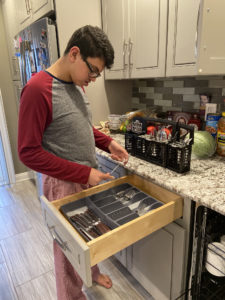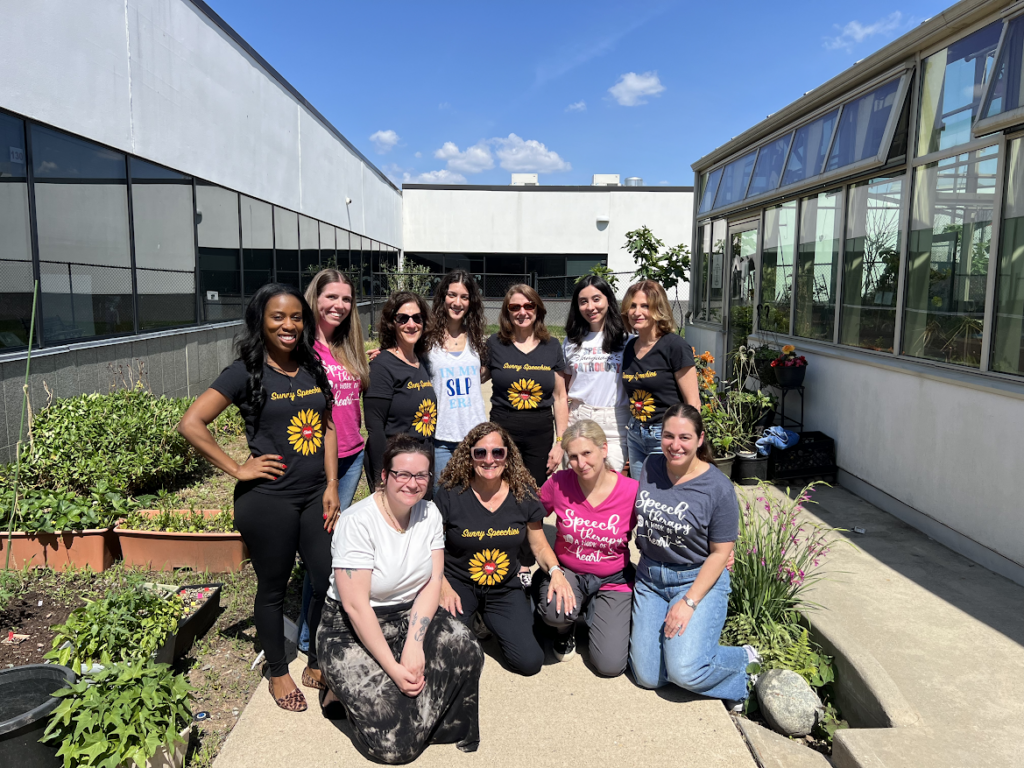Among the many challenges brought by COVID-19, virtually providing students with all-important Life Skills lessons requires a great deal of ingenuity and teamwork. At Spectrum360, our educators, students and their families have truly risen to the occasion.
In pre-COVID-19 times, lessons in cooking, cleaning and other household chores, along with practicing personal hygiene skills, took place in our in-school apartments. Community Based Instruction (CBI) trips to local stores, restaurants and other locations provided lessons in navigating public spaces, interacting with community helpers and handling money.
That was then.
But with CBI outings becoming virtual trips, visits to the life skills apartment now taking place in family homes, and cooking class can be making lunch together over Google Meet, it’s taken creativity to make certain that teaching skills necessary for independence continues whether socially-distanced in classrooms or at home.
* * *
LIFE SKILLS AT HOME
 There’s no question that distance learning has put pressure on everyone, especially parents who are juggling jobs, childcare, and supervising school work; for teachers, who are trying to educate and maintain their connection with groups of students through a computer monitor; and most of all, for our children, teens and adults who are more accustomed to organized classrooms and individual attention.
There’s no question that distance learning has put pressure on everyone, especially parents who are juggling jobs, childcare, and supervising school work; for teachers, who are trying to educate and maintain their connection with groups of students through a computer monitor; and most of all, for our children, teens and adults who are more accustomed to organized classrooms and individual attention.
The silver lining with virtual instruction is that students are in their homes, where life skills can be practiced in a familiar setting rather than in an abstract classroom.
“Making a bed in the life skills apartment is great, but can they make their bed at home?” asks Angela D’Addario, a teacher at Academy360 Upper School. “That’s where they need to demonstrate this skill. Being in the natural environment is good because they’re able to accomplish these skills at home.”
 Life skills classes are organized around weekly themes, for the time being centered on activities that can be safely done during the pandemic. A recent theme focused on laundry, which offered Angela the opportunity to get truly creative:
Life skills classes are organized around weekly themes, for the time being centered on activities that can be safely done during the pandemic. A recent theme focused on laundry, which offered Angela the opportunity to get truly creative:
“If you’re able or willing to open your house, there is a lot you can do with modeling tasks. During laundry week, we sequenced the steps with pictures rather than showing videos. Then, I took my computer to my laundry room and I demonstrated doing my laundry. I narrated for the parents, gave them steps to practice at home. We then used a dresser to practice putting clothes away and also practiced hanging and folding clothes. With me demonstrating the steps, it was a completely different experience.”
 For many students, at-home life skills practice is part of their daily assignments. Rachael Zeigler’s Academy360 Lower School students are asked to send in a photo each day of themselves completing a skill they’re currently acquiring or one they’ve mastered and have integrated into their routine.
For many students, at-home life skills practice is part of their daily assignments. Rachael Zeigler’s Academy360 Lower School students are asked to send in a photo each day of themselves completing a skill they’re currently acquiring or one they’ve mastered and have integrated into their routine.
One of Rachael’s students is a whiz in the kitchen and will share photos of his making lunch independently. Another student is a real go-getter at household chores, and loves sharing his daily accomplishments from washing dishes to vacuuming the house.
The advantages of working in the home environment for students is something teachers keep returning to. Not only for the students, but also for their families, who get to see their independence in action.
“Stu dents are able to practice household chores that were often done by the family before they arrived home or needed to be done quickly. Putting away groceries, setting the table, helping with dinner – to be able to assist at home is learning,” says Caitlin Bonner, of Academy360 Lower School.
dents are able to practice household chores that were often done by the family before they arrived home or needed to be done quickly. Putting away groceries, setting the table, helping with dinner – to be able to assist at home is learning,” says Caitlin Bonner, of Academy360 Lower School.
“Lessons that may seem mundane in the classroom, students can be more involved in at home. They’re learning that tasks can be done in different places, and that’s great,” adds Jennifer Steinhilb, another A360 LS teacher. “It’s tough for some things, but we’re trying to focus on the positive.”
Skills are reinforced with an arsenal of online tools that teachers have discovered and shared during COVID-19 times. Using Kahoot, Google Slides, Boom Cards, and a host of other resources are utilized to create interactive lessons that weren’t always possible in the classroom.
 “One of the good things about doing it virtually is that it gives students the chance to work differently than in the classroom,” Jennifer continues. At school we’d “buy” things from the school store and they practice there. Now we’re creating virtual activities: we’re using Kahoot and other programs to create interactive games and lessons. It’s the same concept, but it’s being delivered differently.”
“One of the good things about doing it virtually is that it gives students the chance to work differently than in the classroom,” Jennifer continues. At school we’d “buy” things from the school store and they practice there. Now we’re creating virtual activities: we’re using Kahoot and other programs to create interactive games and lessons. It’s the same concept, but it’s being delivered differently.”
All students have different strengths that need working on, and some skills in particular may be part of their IEP.
In on-campus classrooms, students work with a teacher or a 1-1 aide to meet the goals of their separate IEPs. In Angela’s virtual classroom, students are still working on IEP objectives, but in groups. For example, during Laundry week, every student had a laundry-oriented task.
“Kids th at aren’t quite there yet, get exposure. The kids who are, get a review. Together they’re tackling skills they need to learn, are learning or have learned, Angela says. “Together they’re working on skills from start to finish.”
at aren’t quite there yet, get exposure. The kids who are, get a review. Together they’re tackling skills they need to learn, are learning or have learned, Angela says. “Together they’re working on skills from start to finish.”
* * *
OUR PARENTS AND STUDENTS
“It takes a village” has never been more true than in these pandemic times.
“COVID-19 has made teaching life skills more of a challenge and we are relying a lot more on home support,” says Caitlin. “We’re working with each other really well and we’re all trying to get through this together.”
 Without parents standing by to observe and assist their children, teaching the ins and outs of doing laundry, helping in the kitchen, cleaning house or dozens of other things would be impossible. And while the situation can be time-consuming, parents are also getting an up-close view of their child’s abilities.
Without parents standing by to observe and assist their children, teaching the ins and outs of doing laundry, helping in the kitchen, cleaning house or dozens of other things would be impossible. And while the situation can be time-consuming, parents are also getting an up-close view of their child’s abilities.
“They do one thing at school and maybe not at home or vice versa, so now parents get to see all aspects and get to be more involved in their learning process,” Caitlin adds. “As difficult as that might be, they can see a lot more of what their children are capable of.”
She continues, “We’ve been supplying a lot of supports for parents to help them with this: video modeling, social stories, instructions for breaking skills into steps for the student to practice. That’s how we work on it in school, one step at a time, from opening the tooth paste to turning off the water when they’re finished.”
One positive outcome of the situation is that teachers and parents have been able to forge a relationship that there wasn’t time for pre-COVID-19. With parents sitting in on classroom and individual sessions, the avenues of communication have opened up.
Angela believes that listening to parents opinions about what is and isn’t working has helped improve all-around satisfaction. “If a parent wants more of one thing or less of another, we work with them to make it happen. We work really hard to give the parent what they want if we can.”
Rachael and all the teachers are proud of their students. “For students who typically don’t do well with inconsistency, who thrive on structure – this is so far out for them,” she says. “But they’ve been amazing. Amazing in school and amazing at home. They keep rising to the occasion.”
Caitlin agrees. “I’m happy how well they’re adapting, though I know it’s rough. Especially with children who are set with routines. School five days a week, then home for two days. Now their routine is totally uprooted and they’re expected to be on the computer for long periods of time. They’re doing the best they can and I’m proud of how well they are.”
* * *
Read more about CBI at Spectrum360:
Teaching Students the Skills They Need For an Independent Life
Practice Makes Perfect – CBI Teaches Skills For The Real World



